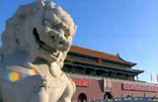China's dual-track challenge can be won
Updated: 2015-03-03 08:00
By Andrew Sheng/xiao Geng(China Daily)
|
|||||||||||
 |
|
Chinese workers look on as metal building materials are lifted at a construction site in Beijing, China, 28 January 2015. Despite a slowdown in economic growth to 7.4 percent in 2014 and an economic growth forecast of 6.8 percent issued by the International Monetary Fund for 2015, China is looking to create some 10 million new jobs in 2015 as part of measures for economic stability. EPA/ROLEX DELA PENA |
With China's economic slowdown more apparent than ever, its prospects of avoiding a hard landing are weakening. Whether policymakers succeed will depend on whether they can navigate the challenges stemming from an increasingly divided dual-track economy.
The latest year-on-year data, from January, highlight the danger. The consumer price index dropped to 0.8 percent; the producer price index fell by 4.3 percent; exports contracted by 3.3 percent; imports were down by 19.9 percent; and the growth of broad money slowed by 1.4 percent.
Moreover, the renminbi has come under downward pressure, owing partly to the economic recovery in the United States, which has fueled capital outflows. Given huge declines in industrial profit growth and local government revenues from land sales, there is considerable anxiety that today's deflationary cycle could trigger corporate and local-government debt crises.
China hopes to secure its long-term economic development by shifting from a State-directed to a market-led economy, but the process has created significant discrepancies in economic performance, with State-owned enterprises performing significantly worse than their private-sector counterparts, despite having better access to credit. And there is a widening disparity between real-estate prices in China's thriving first-and second-tier cities and its lagging third-and fourth-tier cities.
The authorities' task now is to determine how to support continued growth on the better performing track, the private sector and the first-and second-tier cities, while eliminating overcapacity and boosting productivity on the weaker track of SOEs and third - and fourth-tier cities. To succeed, they must address the fallout of the previous approach, which, by providing more money and preferential policies to the lagging track, ended up fueling overcapacity and unsustainable local debts.
In other words, China must confront the sunk costs of bad local-planning decisions. Instead of continuing to hope that bureaucratic intervention can repair flawed projects, officials should take a market-based approach, allowing losses to be allocated through the bankruptcy process, thereby enabling all stakeholders to move on to more productive activities.
The Chinese economy's dual-track structure also presents unique challenges for macro-financial management. As the fast-growing sectors absorb an increasing amount of resources, a shift toward more market-oriented interest rates is needed to ensure efficient allocation. Meanwhile, the slow-growing sectors risk falling into a "balance-sheet recession", with highly indebted SOEs and local governments becoming so focused on paying down their debts that they stop investing in needed infrastructure, even when interest rates fall. As a result, conventional monetary and macro-prudential policies are caught between competing demands for credit, with one track needing to support productive growth and the other attempting to buy time for restructuring.
Related Stories
Growth slowdown not prelude of recession: expert 2015-02-28 17:28
Should we worry about China's economic slowdown? 2015-02-04 08:11
Deflation adds to China's economic slowdown 2015-01-27 09:49
Slowdown brings new risks to banks 2015-01-24 07:58
Today's Top News
Xi gets invitation during meeting Prince William
Treasures stolen from Fontainebleau palace's Chinese museum
Thousands march in Russia to mourn opposition leader Nemtsov
Prince William starts China tour with visit to museum in Beijing
China likely to see surge in hot money from Europe
Debate rages over color of dress photoed in rare light
Russia, China help stabilize global situation
Austria sees record number of tourists in January
Hot Topics
Lunar probe , China growth forecasts, Emission rules get tougher, China seen through 'colored lens', International board,
Editor's Picks

|

|

|

|

|

|





